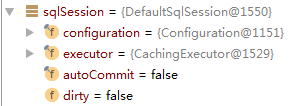Mybatis源码学习(二)简单Demo的运行原理
0 回顾
上一节,我们写了一个简单Demo,并看到了它的运行结果,这一节,我们分析一下Mybatis执行sql的原理。
public class MybatisMain { public static void main(String[] args) throws IOException { String resource = "mybatis-config.xml"; InputStream inputStream = Resources.getResourceAsStream(resource); SqlSessionFactory sqlSessionFactory = new SqlSessionFactoryBuilder().build(inputStream); SqlSession sqlSession = sqlSessionFactory.openSession(); Blog blog = sqlSession.selectOne("org.mybatis.example.BlogMapper.selectBlog", 101); System.out.println(blog.getContext()); } }
1 解析配置文件
InputStream inputStream = Resources.getResourceAsStream(resource);
这一行代码,解析mybatis-config.xml文件,得到一个输入流。我们把xml文件也贴出来
<configuration> <properties resource="jdbc.properties"/> <environments default="development"> <environment id="development"> <transactionManager type="JDBC"/> <dataSource type="POOLED"> <property name="driver" value="${driver}"/> <property name="url" value="${url}"/> <property name="username" value="${username}"/> <property name="password" value="${password}"/> </dataSource> </environment> </environments> <mappers> <mapper resource="mapper/BlogMapper.xml"/> </mappers> </configuration>
这个xml中有3个配置:jdbc.properties,environments,mappers
2 SqlSessionFactory
SqlSessionFactory sqlSessionFactory = new SqlSessionFactoryBuilder().build(inputStream);
这里,得到一个SqlSessionFactory对象,执行完这行代码,实现了对上述xml文件的解析,把配置都保存在该对象的成员变量configuration中。

这些配置信息包括:数据库连接信息、所有Mapper
3 SqlSession
SqlSession sqlSession = sqlSessionFactory.openSession();
该行代码返回SqlSession对象,该对象中包含一个executor变量,默认为CachingExecutor对象(一级缓存)。这个executor对象是实际查询时的执行器。
public SqlSession openSession() { return openSessionFromDataSource(configuration.getDefaultExecutorType(), null, false); }
这里可以看出来,mybatis默认是手动提交事务的(详情见附录2)。JDBC默认是自动提交,spring整合mybatis后默认是自动提交。
这里调用了openSessionFromDataSource方法
private SqlSession openSessionFromDataSource(ExecutorType execType, TransactionIsolationLevel level, boolean autoCommit) { Transaction tx = null; try { final Environment environment = configuration.getEnvironment(); final TransactionFactory transactionFactory = getTransactionFactoryFromEnvironment(environment); tx = transactionFactory.newTransaction(environment.getDataSource(), level, autoCommit); final Executor executor = configuration.newExecutor(tx, execType);//public enum ExecutorType {SIMPLE, REUSE, BATCH},默认为SIMPLE.为什么默认为SIMPLE?Configuration对象的defaultExecutorType属性默认值就是SIMPLE,除非对其进行了显式设置 return new DefaultSqlSession(configuration, executor, autoCommit); } catch (Exception e) { closeTransaction(tx); // may have fetched a connection so lets call close() throw ExceptionFactory.wrapException("Error opening session. Cause: " + e, e); } finally { ErrorContext.instance().reset(); } }
上面代码创建了使用了很多对象的引用,比如Environment,TransactionFactory,DataSourceFactory等,他们是如何实例化的,以及他们的具体类型为什么是JdbcTransactionFactory,PooledDataSourceFactory?为什么默认开启一级缓存?感兴趣的话请看最下面的附录。
创建Executor,默认创建的是SimpleExecutor,如果开启了一级缓存,则使用CachingExecutor进行了封装。
public Executor newExecutor(Transaction transaction, ExecutorType executorType) { executorType = executorType == null ? defaultExecutorType : executorType; executorType = executorType == null ? ExecutorType.SIMPLE : executorType; Executor executor; if (ExecutorType.BATCH == executorType) { executor = new BatchExecutor(this, transaction); } else if (ExecutorType.REUSE == executorType) { executor = new ReuseExecutor(this, transaction); } else { executor = new SimpleExecutor(this, transaction); } if (cacheEnabled) { executor = new CachingExecutor(executor); } executor = (Executor) interceptorChain.pluginAll(executor); return executor; }
最终返回一个包含CachingExecutor对象的SqlSession。

4 执行查询
Blog blog = sqlSession.selectOne("org.mybatis.example.BlogMapper.selectBlog", 101);
执行selectOne方法
public <T> T selectOne(String statement, Object parameter) { // Popular vote was to return null on 0 results and throw exception on too many. List<T> list = this.selectList(statement, parameter); if (list.size() == 1) { return list.get(0); } else if (list.size() > 1) { throw new TooManyResultsException("Expected one result (or null) to be returned by selectOne(), but found: " + list.size()); } else { return null; } }
执行selectList方法
private <E> List<E> selectList(String statement, Object parameter, RowBounds rowBounds, ResultHandler handler) { try { MappedStatement ms = configuration.getMappedStatement(statement); return executor.query(ms, wrapCollection(parameter), rowBounds, handler); } catch (Exception e) { throw ExceptionFactory.wrapException("Error querying database. Cause: " + e, e); } finally { ErrorContext.instance().reset(); } }
调用CachingExecutor的query方法,判断缓存中是否有记录,如果有,取缓存中的记录,如果没有,则调用SimpleExecutor中的query查询数据库
public <E> List<E> query(MappedStatement ms, Object parameterObject, RowBounds rowBounds, ResultHandler resultHandler, CacheKey key, BoundSql boundSql) throws SQLException { Cache cache = ms.getCache(); if (cache != null) { flushCacheIfRequired(ms); if (ms.isUseCache() && resultHandler == null) { ensureNoOutParams(ms, boundSql); @SuppressWarnings("unchecked") List<E> list = (List<E>) tcm.getObject(cache, key); if (list == null) { list = delegate.query(ms, parameterObject, rowBounds, resultHandler, key, boundSql); tcm.putObject(cache, key, list); // issue #578 and #116 } return list; } } return delegate.query(ms, parameterObject, rowBounds, resultHandler, key, boundSql); }
然后,执行SimpleExecutor的doQuery方法
public <E> List<E> doQuery(MappedStatement ms, Object parameter, RowBounds rowBounds, ResultHandler resultHandler, BoundSql boundSql) throws SQLException { Statement stmt = null; try { Configuration configuration = ms.getConfiguration(); StatementHandler handler = configuration.newStatementHandler(wrapper, ms, parameter, rowBounds, resultHandler, boundSql); stmt = prepareStatement(handler, ms.getStatementLog()); return handler.query(stmt, resultHandler); } finally { closeStatement(stmt); } }
这个方法就是我们使用JDBC查询数据库的代码。
我们再回到刚开始的这行代码
Blog blog = sqlSession.selectOne("org.mybatis.example.BlogMapper.selectBlog", 101);
从上面分析来看,我们执行这行代码之后,最终返回给我们的是一个Blog对象,包含了数据库记录。
这就是我们执行mybatis的过程。
附录1 mybatis-config.xml的解析过程
mybatis-config.xml文件是mybatis的主要配置文件,里面配置了Enviroment列表,每个Environment中transactionManager的类型、dataSource的类型等重要配置。以及所有的mappers
<?xml version="1.0" encoding="UTF-8" ?> <!DOCTYPE configuration PUBLIC "-//mybatis.org//DTD Config 3.0//EN" "http://mybatis.org/dtd/mybatis-3-config.dtd"> <configuration> <properties resource="jdbc.properties"/> <environments default="development"> <environment id="development"> <transactionManager type="JDBC"/> <dataSource type="POOLED"> <property name="driver" value="${driver}"/> <property name="url" value="${url}"/> <property name="username" value="${username}"/> <property name="password" value="${password}"/> </dataSource> </environment> </environments> <mappers> <mapper resource="mapper/UserMapper.xml"/> </mappers> </configuration>
在上面main函数中,
SqlSessionFactory sqlSessionFactory = new SqlSessionFactoryBuilder().build(inputStream);
这行代码用于实例化SqlSessionFactory,
然后调用了
public SqlSessionFactory build(InputStream inputStream) { return build(inputStream, null, null); }
然后
public SqlSessionFactory build(InputStream inputStream, String environment, Properties properties) { try { XMLConfigBuilder parser = new XMLConfigBuilder(inputStream, environment, properties); return build(parser.parse()); } catch (Exception e) { throw ExceptionFactory.wrapException("Error building SqlSession.", e); } finally { ErrorContext.instance().reset(); try { inputStream.close(); } catch (IOException e) { // Intentionally ignore. Prefer previous error. } } }
上面代码首先创建一个XMLConfigBuilder实例,在其构造方法中创建一个Configuration实例。
private XMLConfigBuilder(XPathParser parser, String environment, Properties props) { super(new Configuration()); ErrorContext.instance().resource("SQL Mapper Configuration"); this.configuration.setVariables(props); this.parsed = false; this.environment = environment; this.parser = parser; }
其中Configuration实例中有一些比较重要的东西,比如typeAliasRegistry对象,其中包含了72种类型对应的默认具体类。比如:
typeAliasRegistry.registerAlias("JDBC", JdbcTransactionFactory.class);
typeAliasRegistry.registerAlias("MANAGED", ManagedTransactionFactory.class);
typeAliasRegistry.registerAlias("JNDI", JndiDataSourceFactory.class);
typeAliasRegistry.registerAlias("POOLED", PooledDataSourceFactory.class);
typeAliasRegistry.registerAlias("UNPOOLED", UnpooledDataSourceFactory.class);
这些配置对后续的对象实例化非常有用,决定了这些对象的具体实现类是什么(比如TransactionFactory的默认实现类是JdbcTransactionFactory)
然后,我们回到build方法,我们看一下其中调用的parse方法
public Configuration parse() { parseConfiguration(parser.evalNode("/configuration")); return configuration; }
然后
private void parseConfiguration(XNode root) { try { // issue #117 read properties first propertiesElement(root.evalNode("properties")); Properties settings = settingsAsProperties(root.evalNode("settings")); loadCustomVfs(settings); loadCustomLogImpl(settings); typeAliasesElement(root.evalNode("typeAliases")); pluginElement(root.evalNode("plugins")); objectFactoryElement(root.evalNode("objectFactory")); objectWrapperFactoryElement(root.evalNode("objectWrapperFactory")); reflectorFactoryElement(root.evalNode("reflectorFactory")); settingsElement(settings); // read it after objectFactory and objectWrapperFactory issue #631 environmentsElement(root.evalNode("environments")); databaseIdProviderElement(root.evalNode("databaseIdProvider")); typeHandlerElement(root.evalNode("typeHandlers")); mapperElement(root.evalNode("mappers")); } catch (Exception e) { throw new BuilderException("Error parsing SQL Mapper Configuration. Cause: " + e, e); } }
我们主要看一下标红的这一行
下面代码进行了删减,只看重要部分
private void environmentsElement(XNode context) throws Exception { TransactionFactory txFactory = transactionManagerElement(child.evalNode("transactionManager")); DataSourceFactory dsFactory = dataSourceElement(child.evalNode("dataSource")); DataSource dataSource = dsFactory.getDataSource(); Environment.Builder environmentBuilder = new Environment.Builder(id) .transactionFactory(txFactory) .dataSource(dataSource); configuration.setEnvironment(environmentBuilder.build()); }
我们以实例化TransactionFactory为例,在下面代码中获取xml文件中的type: <transactionManager type="JDBC"/> ,然后
private TransactionFactory transactionManagerElement(XNode context) throws Exception { if (context != null) { String type = context.getStringAttribute("type"); Properties props = context.getChildrenAsProperties(); TransactionFactory factory = (TransactionFactory) resolveClass(type).getDeclaredConstructor().newInstance(); factory.setProperties(props); return factory; } throw new BuilderException("Environment declaration requires a TransactionFactory."); }
这里会根据上面提到的typeAliasRegistry对象中保存的72种对应关系决定TransactionFactory的具体实现类。
也就是解决了这个疑问,为什么创建的TransactionFactory是JdbcTransactionFactory?( <transactionManager type="JDBC"/> )
同样的道理,DataSourceFactory对应的具体实现类是PooledDataSourceFactory ( <dataSource type="POOLED"> )
然后,我们返回再看一下environment方法
private void environmentsElement(XNode context) throws Exception { if (context != null) { if (environment == null) { environment = context.getStringAttribute("default"); } for (XNode child : context.getChildren()) { String id = child.getStringAttribute("id"); if (isSpecifiedEnvironment(id)) { TransactionFactory txFactory = transactionManagerElement(child.evalNode("transactionManager")); DataSourceFactory dsFactory = dataSourceElement(child.evalNode("dataSource")); DataSource dataSource = dsFactory.getDataSource(); Environment.Builder environmentBuilder = new Environment.Builder(id) .transactionFactory(txFactory) .dataSource(dataSource); configuration.setEnvironment(environmentBuilder.build()); break; } } } }
如下代码把txFactory对象和dataSource对象放到了Environment的实例中,然后把这个Environment实例放到configuration对象中。
Environment.Builder environmentBuilder = new Environment.Builder(id) .transactionFactory(txFactory) .dataSource(dataSource); configuration.setEnvironment(environmentBuilder.build());
至此,解析xml文件中的<environments>标签完毕( environmentsElement(root.evalNode("environments")); )
其他标签的解析后面有时间再添加。
附录2 有关自动提交
附录3 纯JDBC
相关介绍参考:https://www.liaoxuefeng.com/wiki/1252599548343744/1321748435828770
public class PureJDBC { static final String DB_URL = "jdbc:mysql://xxx:3306/xxx?useUnicode=true&characterEncoding=utf8&useSSL=false&allowPublicKeyRetrieval=true&serverTimezone=GMT%2B8&zeroDateTimeBehavior=CONVERT_TO_NULL"; static final String USER = "xxx"; static final String PASS = "xxx"; public static void main(String[] args) { Connection conn = null; Statement stmt = null; try{ Class.forName("com.mysql.jdbc.Driver"); //开启一个连接 conn = DriverManager.getConnection(DB_URL, USER, PASS); System.out.println("是否自动提交:"+conn.getAutoCommit()); //执行查询 stmt = conn.createStatement(); String sql = "select * from t_user where uid='xxx'"; ResultSet rs = stmt.executeQuery(sql); while(rs.next()){ String uname = rs.getString("uname"); System.out.print("uname: " + uname); } rs.close(); }catch(SQLException se){ se.printStackTrace(); }catch(Exception e){ e.printStackTrace(); }finally{ try{ if(stmt!=null) conn.close(); }catch(SQLException se){} try{ if(conn!=null) conn.close(); }catch(SQLException se){ se.printStackTrace(); } } } }
执行结果
是否自动提交:true uname: xxx
从执行结果看,JDBC方式,事务是自动提交的




